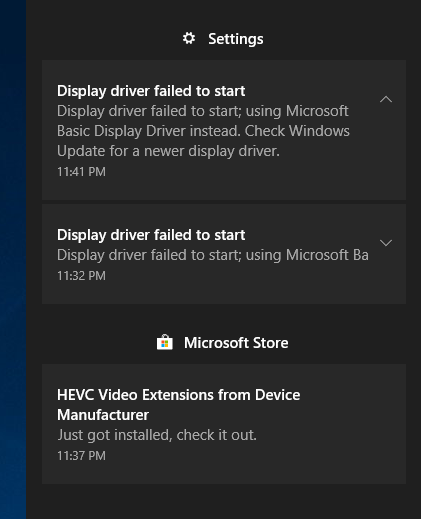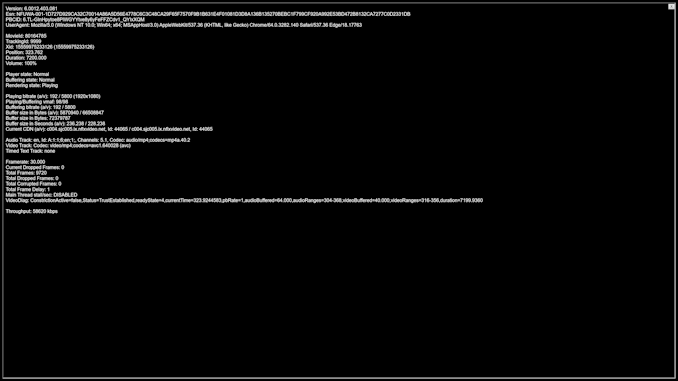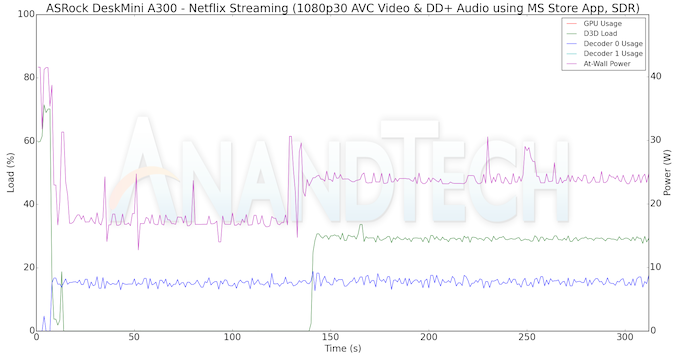The ASRock DeskMini A300 Review: An Affordable DIY AMD Ryzen mini-PC
by Ganesh T S on April 26, 2019 8:00 AM ESTHTPC Credentials - YouTube and Netflix Streaming
Streaming of 4K OTT content with YouTube and Netflix has become mainstream. HDR displays have also started becoming affordable. In order to evaluate YouTube HDR streaming support, we have the Mystery Box's Peru 8K HDR 60FPS video as our test sample. On PCs running Windows, it is recommended that HDR streaming videos be viewed using the Microsoft Edge browser after putting the desktop in HDR mode.
HDR content on YouTube is encoded exclusively in VP9 Profile 2. On systems supporting hardware accelerated decoding of VP9 Profile 2, Edge streams and decodes the HDR stream. The DeskMini A300 passes this test, and we can see HDR YouTube videos, as shown in the picture above.
Various metrics of interest such as GPU usage and at-wall power consumption were recorded for the first four minutes of the playback of the above video. The numbers are graphed below.
Decoding 4Kp60 VP9 Profile 2 videos consumes between 70 and 90% of one of the decoder engines. We also see some Direct3D loading of the order of 70% initially (when the stream being played back is at a lower resolution and needs to be upscaled to 4K). Once the stream stabilizes and the system starts decoding the 4K stream, the Direct3D loading settles around 50%. The average at-wall power consumption for streaming 4K YouTube HDR videos is around 33W.
4K HDR streaming in Netflix requires support for hardware-accelerated decoding of HEVC Main 10 videos. Microsoft removed the in-built HEVC decoding capabilities of Windows 10 in the 2017 Fall Creators Update, and replaced it with an extension that had to be downloaded from the Microsoft Store. Without the extension, playback is restricted to 1080p non-HDR streams encoded in H.264. In addition to the decoding capabilities, the system also needs to support PlayReady 3.0 DRM. In our tests with the Radeon 19.4.2 driver release, we ran into major problems.
Our usual testing flow involves the installation of the HEVC Video Extensions and the Netflix apps from the Microsoft Store. After configuring the Netflix login credentials, we attempt to play back Season 4 Episode 4 of the Netflix Test Patterns title. Unfortunately, the DeskMini A300 behaves in an unexpected manner when subject to the above steps. As soon as the playback of the title starts, the screen goes blank and the display driver crashes.
Windows reverts to the basic display driver, and the Netflix title continues to play back. However, instead of the expected 4Kp60 HEVC Main 10 stream (with HDR), we only get a 1080p30 AVC stream. In order to prevent the crashing of the driver in the course of our evaluation, we opted to uninstall the HEVC Video Extensions app, and make use of only the AVC decoder built into Windows. Without the HEVC Video Extensions, the driver has no problem with standard 1080p Netflix streaming. The OS screenshot facilities obviously can't capture the video being played back. However, the debug OSD (reachable by Ctrl-Alt-Shift-D) can be recorded.
The (avc) entry corresponding to the Video Track in the debug OSD, the Framerate (30.000), and with the A/V bitrate details (192 kbps / 5800 kbps) indicate that we are only getting a low quality 1080p stream compared to the best available one (4Kp60 16 Mbps HEVC Main 10 HDR stream). Similar to the YouTube streaming case, metrics such as GPU usage and at-wall power consumption were recorded for the first three minutes of the playback of the title. The numbers are graphed below.
1080p30 AVC playback is a walk in the park for modern computing systems. We see that the Direct3D loading is only around 30% and the decoder usage is less than 20% in the steady state. The former is mainly due The at-wall power consumption is around 24W for this workload.















88 Comments
View All Comments
Alexvrb - Saturday, April 27, 2019 - link
I just want to know if it supports cTDP, and if so, does it work well. Some boards do better than others.CharonPDX - Friday, April 26, 2019 - link
Now that "integrated graphics" are starting to reach actually-usable levels, I'd like to see VR added to these SFF reviews. We keep the Oculus Rift in the living room, but have to bring the "gaming PC" out every time we want to use it. I'd love to get a small "capable enough for basic VR games" PC to just live in the living room to run the Oculus.Relatedly, it mentions the DP, HDMI, and VGA ports - but does the front panel USB-C port allow video output via DisplayPort Alternate Mode? If it can play basic VR games acceptably (BeatSaber is the big one,) I'd rather use the front-panel USB-C with one of Accell's USB-C VR adapters.
GreenReaper - Friday, April 26, 2019 - link
It's "usable" up to 1080p on a single screen. Most VR systems use resolutions higher than this, one in each eye, and require twice the frame rates offered here. Don't get me wrong: I want this too, but if top-end Navi-based APUs *doubled* performance they'd still struggle, and they're a year away. Maybe if we had a dual-APU system? (Man, now I'm imagining this for a console.)piasabird - Friday, April 26, 2019 - link
I have the Intel 310 version of the Desk Mini. I think on your review it is too technical while not stressing the ease at which a 2.5 SSD can be installed. The Data/power connectors on the back of the motherboard make it fairly easy and with not much cable clutter. However, I found the cables were easier to connect if you remove the motherboard first. Since some people may want to use a 2.5 SSD, you should have tested that. I wish a similar design was available in Mini-ITX. However, it seems unavailable on the consumer level for the most modern CPU's like the one used in this review.mikato - Tuesday, April 30, 2019 - link
I completely agree. I don't think it was mentioned anywhere in the review that you can add a 2.5" drive - and you can actually add 2 x 2.5" drives according to the ASRock specs page. That sets it apart from other mini PCs significantly. Most only support 1 x 2.5" drive, or the thin NUCs don't support any. That gives you some solid storage options. You can actually forgo the media server and have both ends of the HTPC in one compact box (front-end with all streaming options, and the file storage for local media).sor - Friday, April 26, 2019 - link
I picked up two for my kids, with 2400Gs. Can’t beat the price. I have them mounted to the backs of their monitors which makes for a compact powerful all in one.I’ve got Ubuntu 19.04 on them and they run Dota2 like butter. Better than my 2018 MacBook Pro with discrete Radeon 560x.
My only ask might be two more rear USB ports, but it hasn’t been an issue so far.
sor - Friday, April 26, 2019 - link
Come on guys! The wraith cooler fits and is clearly superior to the boxed one.It may not be listed as supported dimensionally, but you just need to take the superficial ring off the fan and you can ease it in with a little care.
oliwek - Saturday, April 27, 2019 - link
Or just add a low profile Noctua cooler, it's dead silent even under full load, and you won't ever see (nowhere near) 80 degrees celsius as with the stock cooler!https://noctua.at/en/nh-l9a-am4
sor - Friday, April 26, 2019 - link
I just checked and I’m averaging about 57FPS on my 2400G deskmini A300w in 1080p, all settings max.That’s about 50% better performance than the review sees, which is huge. I am running Ubuntu 19.04 out of the box (no munching with drivers).
I AM using the wraith cooler as mentioned, which is also a difference. Are the windows drivers that bad? Or is it the cooler, or something else?
oliwek - Saturday, April 27, 2019 - link
The stock cooler is adequate for a 35watts athlon 200ge, but I'd avoid those high temps with 65W APUs we see here. I don't understand why not to mod the Wraith cooler as you chose to, as it's delivered with the processor, or else take an aftermarket low profile cooler (the Noctua looks like it was designed around this A300 motherboard).